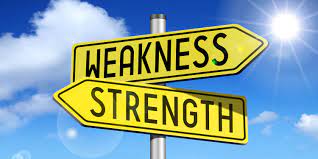Strengths and weaknesses are two important aspects of personal development that everyone should understand. By identifying and leveraging your strengths, you can enhance your productivity, self-confidence, and overall well-being. On the other hand, by recognizing and addressing your weaknesses, you can take steps to improve your performance and overcome challenges.
In this blog, we will explore the concept of strengths and weaknesses, their importance in personal and professional growth, and strategies for identifying and improving them.
What are strengths?
Strengths are the positive traits, skills, and attributes that come naturally to a person. These can be physical, emotional, intellectual, or social. They represent an individual’s unique talents and abilities that they can use to achieve their goals and excel in their personal and professional life.
Strengths can vary from person to person, but some common examples include:
Creativity
Leadership
Critical thinking
Empathy
Communication
Organization
Flexibility
Resilience
Problem-solving
Time management
Identifying your strengths is crucial because it allows you to focus on what you’re good at and use those strengths to achieve your goals. By leveraging your strengths, you can enhance your productivity, boost your self-confidence, and create a positive impact on those around you.
What are weaknesses?
Weaknesses are the areas where a person lacks knowledge, skills, or experience. These can be personal or professional, and they represent the obstacles that can hinder a person’s growth and development. Weaknesses can be minor or significant, and they can vary from person to person.
Some common weaknesses include:
Poor time management
Lack of communication skills
Difficulty in handling stress
Limited adaptability
Lack of self-confidence
Procrastination
Inability to take feedback
Poor organizational skills
Recognizing your weaknesses is important because it helps you identify areas where you need to improve. By addressing your weaknesses, you can take steps to overcome obstacles and achieve your goals.
Why is it important to identify strengths and weaknesses?
Identifying your strengths and weaknesses is crucial for personal and professional growth. It allows you to focus on your strengths and use them to your advantage while taking steps to address your weaknesses and overcome challenges.
Here are some reasons why identifying your strengths and weaknesses is important:
Enhanced productivity: By identifying your strengths, you can focus on tasks that align with your abilities, which can increase your productivity and efficiency.
Improved self-awareness: Recognizing your weaknesses can help you understand your limitations and areas where you need to improve. This can lead to greater self-awareness and self-improvement.
Increased confidence: Leveraging your strengths can boost your self-confidence, which can help you take on new challenges and achieve your goals.
Career development: Understanding your strengths and weaknesses can help you make informed decisions about your career path and identify areas where you need to improve to advance in your field.
Better relationships: Knowing your strengths and weaknesses can help you communicate more effectively with others and build better relationships.




